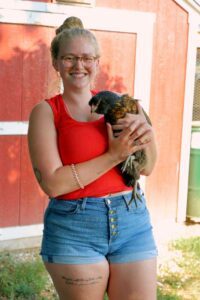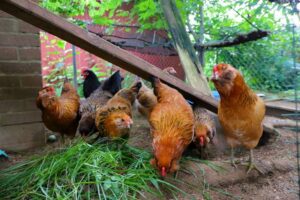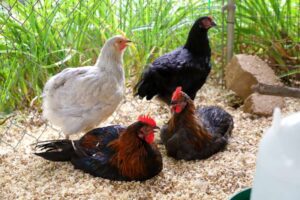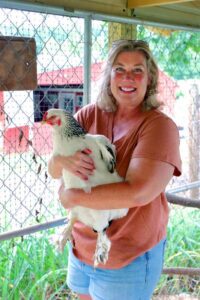by Lois Szymanski , photography by Nikola Tzenov

The COVID-19 pandemic presented a unique set of challenges that forced individuals and families to re-evaluate their lifestyles and daily routines. As lockdowns and restrictions limited social interactions and disrupted the food supply chain, many people sought ways to become more self-sufficient. In response, there has been a notable surge in the number of individuals who turned to backyard chicken keeping as a means of ensuring a steady supply of fresh eggs and reconnecting with nature. This unexpected influx of new chicken owners has not only brought a sense of security but has also introduced countless individuals to the joys and rewards of raising the birds.
Thinking of adding some chickens to your homestead? Before you set up your coop, here’s a few things you should know — brought to you by your Carroll County neighbors.
Do your research
Twenty-one-year-old Macey Rutter keeps chickens at her parents’ home in New Windsor. She suggests new chicken owners do some research first.
“Read up on chickens. Learn everything you possibly can before getting them,” she said.
Bryan Butler, principal agent in agriculture and food systems for
the Carroll County Extension Office, urges those interested in getting chickens to first check if they are allowed to.
“The rules in each town vary,” he said. “So check with your town or municipality, and consider the rules of your [homeowners’ association] as well.”
Know the expenses
Amy Thompson loves having chickens at her Taneytown residence. She suggests budgeting start-up and continuing costs. You’ll need a well-fortified coop — one you build yourself, buy ready-made, or create by refurbishing an existing building.

More space is better, since overcrowding can lead to disease, and happy chickens make good layers, and an outdoor run is a must. If you start with chicks, you’ll need a brooder. That’s where the chicks live until they’re old enough to graduate to the henhouse. Rutter said the startup can be overwhelming.
“My family helped a ton in the beginning,” Rutter said. “We probably spent $2,000 to start and we didn’t do anything fancy. We go through about $100 worth of feed a month [for 30 chickens].”
 Three to five square feet of floor space per chicken in the hen house is a good estimate, with room for a feeder, water containers and one laying box for every three or four chickens. Add a roosting bar inside the coop and plan about 8 inches of roosting bar per bird.
Three to five square feet of floor space per chicken in the hen house is a good estimate, with room for a feeder, water containers and one laying box for every three or four chickens. Add a roosting bar inside the coop and plan about 8 inches of roosting bar per bird.
Thompson said to factor in the cost of your chicks, feed and bedding, water and pest control, as well as some chicken meds — because, she said, they will get sick.
Manchester resident Catie Garrett inherited her chickens from a friend who was keeping them at her home.
“We’ve had chicks, and when friends had to move, we took their full-grown birds. Chicks [cost] roughly $4 each. Older birds get more expensive. Recently I got some Buff Orpingtons for $15 each.”

“For my 15 chickens, I spend about $36 dollars a week on feed,” Thompson said. “But that will vary on the number of birds you have and whether or not you have free-range chickens.” She does not.
“When egg prices went up everyone wanted chickens,” Sykesville chicken owner Wendy Dickey said. “But, as my husband said, ‘We do not get our money’s worth in eggs.’ Still, I love my chickens. I like knowing where my eggs come from.”
All four chicken owners use pine shaving bedding, but Garrett uses sand as well, and Rutter is planning a slight change.
“We’re going to start using [wood] ash with the pine shavings,” she said. “We were told it’s good for killing bacteria and smell.”
Thompson uses about one bag of pine shavings per coop, cleaning every two weeks, spending about $12 every two weeks on bedding for 15 chickens.
Beware of predators

Chickens have predators. In Carroll County, that includes foxes, birds of prey, raccoons, the occasional coyote, and even cats and dogs.
“Sadly, we’ve had many instances of foxes getting our birds,” Garrett said. “That’s the tough part of this, especially when it’s our favorites.”
Dickey suggested wire under-footing and extra netting over the coop. Predators have reached her chickens twice.
“Their run is enclosed with netting overtop, but five or six years ago a raccoon got in,” she said. “He killed one in the barn and four in the yard. Then, two years ago, a hawk got into my run. I don’t know how that happened. He killed one chicken, but then was stuck in the run. I had a neighbor come get him out.”
Rutter, Thompson and Dickey all say having a variety of chickens is more fun, especially when they lay different colored eggs. Between them, they have a variety of breeds, including Delaware, Brahma, Black Sexlink, Leghorn, Orpington, Cochin, Blue Maran, Easter Egger and Americana, to name a few.
Boys or girls?
If you buy peeps, it helps to know if you’re going to have hens or roosters. Autosex breeds are sexed by the color of the peep. If you’re buying a breed that isn’t an autosex breed, look for pullet peeps. They offer an 80 percent to 90 percent guarantee of hens, although you could still end up with a male.
Even though a nice rooster can help protect the flock and offer opportunities to raise chicks from your own eggs, most are known to turn nasty.
Both Thompson and Rutter abandoned having roosters after they started to attack.
“They can turn at any moment,” Rutter said. “My 2-year old nephew and I got attacked by my last rooster two weeks ago — and we will never have a rooster again.”
Eventually, they all become pets
Chickens don’t lay eggs year-round. In the spring and summer, good layers produce daily, but as the days grow shorter, egg production drops.
 Hens lay best the first two or three years of their lives, after which production drops by about 20 percent annually until it stops. Chickens may live up to 10 years. And when they stop producing, they become nice pets.
Hens lay best the first two or three years of their lives, after which production drops by about 20 percent annually until it stops. Chickens may live up to 10 years. And when they stop producing, they become nice pets.
Dickey said it was unexpected to learn how chickens each have their own personality.
“One of my Cinnamon Queens is my favorite,” she said. “She runs right to me everyday. When I feed everyone, she hops right into the feed bin like it is her smorgasbord.”
Thompson agreed.

“They actually have the ability to recognize faces and voices. When I call my chickees for treats they all come running. Some get so excited that they jump up and down. I’ve trained one to jump on command when I ask if she wants treats! I have another one that shows me her egg after she lays one. She’s very proud. She’ll jump on the nest box and squawk until I come look at her egg and collect it. Then, I have to tell her what a good chickee she is for laying such a beautiful egg.”
Garrett has a degree in animal and poultry sciences, but she said she’s learned more about chicken personalities by having them in her life. “I was surprised at how quickly these velociraptors recognized all of us,” she said. “Double your budget. You’ll fall in love with them!”
Why chickens …
Despite the work and expense, chicken owners say it’s good to know where your food comes from.
“I love having fresh eggs, and knowing what went into them,” Dickey said.
Garrett agreed, then added more. “They help teach problem-solving, empathy, and appreciation for where our food comes from,” she said. “I think chickens are an exceptional animal that doesn’t get enough credit for their role in humanity.”













